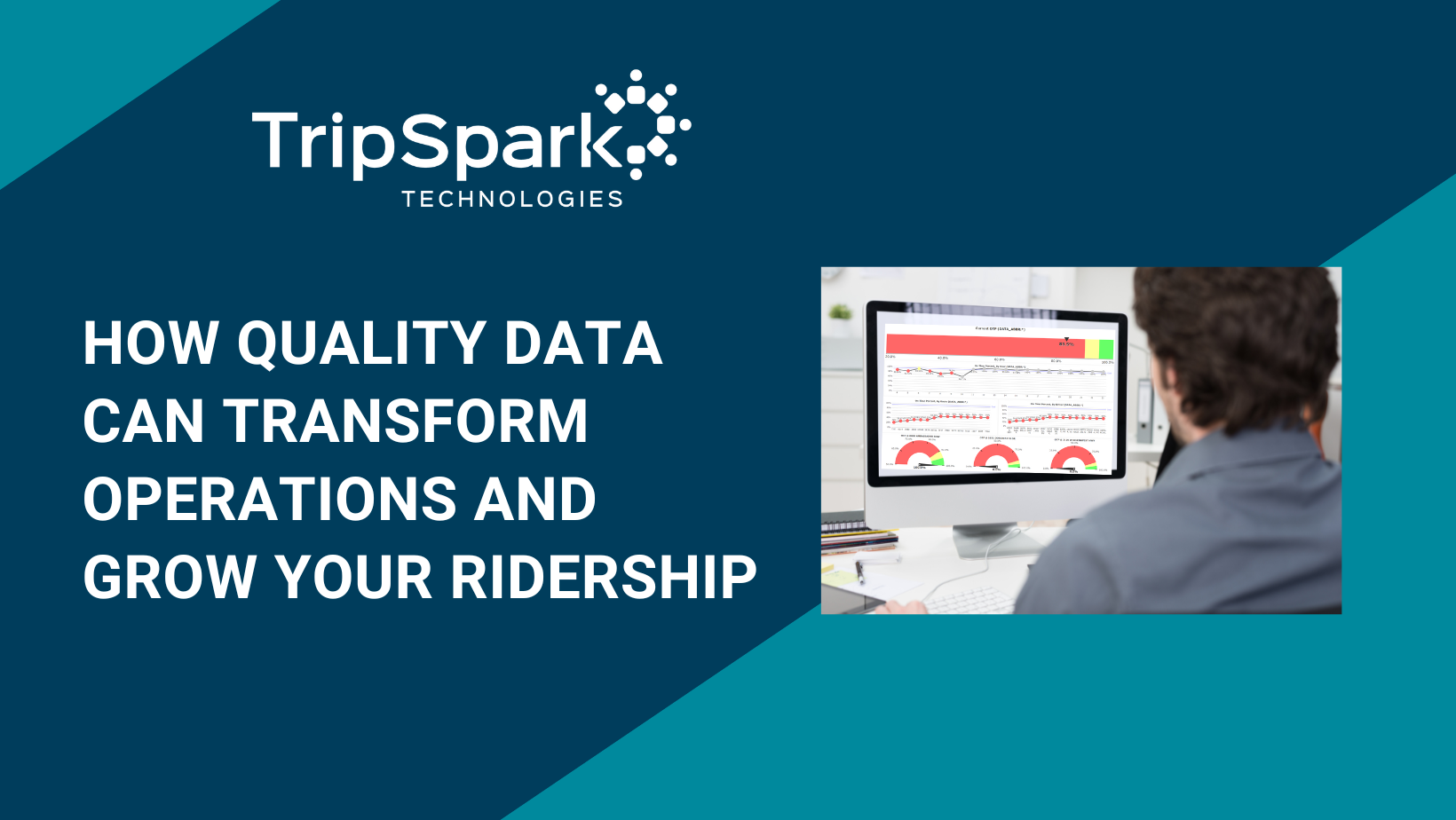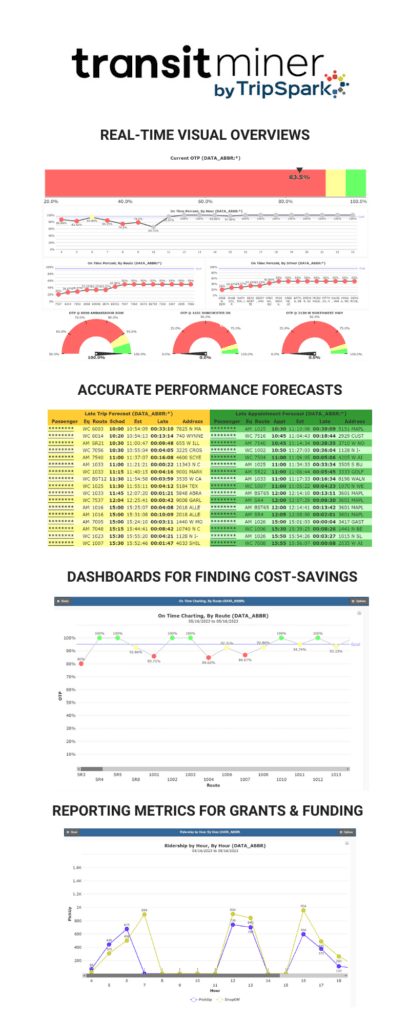How Quality Data Can Transform Operations and Grow Your Ridership

Public transit agencies collect a lot of data from AVL systems, passenger counters, and fareboxes. This data contains a treasure trove of insights about trips, vehicle performance, travel patterns, plus passenger behavior and preferences that can help you improve services and attract more riders.
The problem lies with agencies not having enough resources or time to sort through the amount of data generated daily. Compounding this challenge is confusion over the benefits of transit data and not knowing what to do with it. For agencies using manual systems like spreadsheets or local desktop applications for managing data, there’s also the likelihood that the quality of data is too poor to provide any meaningful intelligence.
High quality data can help your agency make better data-driven decisions instead of relying on guesswork. Why is that important? How can data collected from your software and hardware transform your operations and grow ridership?
TripSpark is here to answer questions about the value of transit data and how to mine your data for golden insights.
Why Is Quality Data Important for Agencies?
We can think of several reasons why quality data is important for your agency, including:
- Understanding how your services and operations are working to make targeted improvements.
- Reducing costs and using resources more efficiently.
- Predicting factors that negatively impact on-time performance.
- Reducing complaints and improving customer experience.
- Improving reporting for grant applications and NTD requirements.
Without quality data that can be analyzed and leveraged for insights, you can’t make informed business decisions. You’re pretty much operating in the dark and making decisions without the numbers to back you up. When your reputation with the community, board or council depend on transparency about how your agency is running, the insights you learn and can share from your data immeasurably boost accountability with stakeholders.
The Benefits of Quality Transit Data
According to the APTA’s Leveraging Big Data in the Public Transportation Industry (the “APTA Policy Brief”), 94% of the agencies surveyed indicated they are using Big Data techniques and methods to improve their operations or maintenance. This is because quality data helps you improve:
Service and operations planning
Good data helps you fully optimize service planning and scheduling. Data on schedule adherence, running times, load vs. capacity, and ridership at the stop level is great for measuring against service standards and business KPIs. With this data, you can improve the design of route schedules, identify better stop locations, address delays, reduce idle vehicles, and much more to keep customers efficiently moving.
Vehicle maintenance
When vehicles break down, your agency loses time and money, and puts the safety of drivers and riders at risk. Quality data can help you stay ahead of vehicle malfunctions and any state of good repair issues. By using predictive modeling with transit data, you can also anticipate bus breakdowns and when equipment needs to be replaced before it becomes too expensive. Vehicles in good working condition have better on-time performance and give you peace of mind you’re providing customers a safe journey.
Sharing information with riders
Building trust with customers is vital for growing your ridership. Poor quality data from disparate data management systems can result in inaccurate scheduling that frustrates customers and turns them off using public transit. High quality data that your agency uses for accurate schedules, real-time pick-up times, vehicle locations, and service alerts helps customers feel more confident about taking public transit.
Working with government stakeholders
Armed with solid data about your route performance and ridership trends you can confidently work with government stakeholders to improve services and attract more riders. With forecasts and predictions based on historic and current data, you can present the anticipated future needs of your agency, making a case for funding new initiatives. The route data you collect can also help local governments understand how supporting your agency can help reduce traffic congestion and serve more members of the community.
Challenges with Data Management
The challenge transit agencies have with data is there’s volumes of it, and it requires structured organizing and management for you to analyze and gain the insights that can transform transit operations. Yet, many agencies use manual methods for managing data like Excel spreadsheets or local desktop applications like Microsoft Access or Visual Basic.
While these methods may be helping you get by, both are error-prone, and lack the scalability and functionality necessary to get business intelligence from your data. When your agency needs to manage and store large datasets, a web-based platform designed to help you extract actionable insights from your data is a long-term solution for making more informed operational decisions.

How to Transform Data into Transit Excellence
You can only make decisions as good as your data. A business intelligence platform can help you aggregate and validate large datasets of historic and current information.
You can unlock powerful insights that help with:
- Understanding on-time performance statistics and looking ahead with forecasts.
- Redesigning routes and schedules for efficiency and cost-savings.
- Predicting vehicle maintenance requirements.
- Identifying trends and patterns to improve customer experience.
High quality data is now essential if agencies want to improve the services that keep and attract riders. By having all your data in a centralized location, you can not only see how your transit agency is performing, but also deep dive into the factors hampering the growth of ridership.
The APTA Policy Brief reveals that 59% of survey respondents stated that data quality issues were an obstacle. A business intelligence platform can also help you improve the quality of data by revealing information that’s missing or inaccurate.
TransitMiner is a business intelligence platform that provides a complete picture of your agency’s historical, real-time, and anticipated performance with an extensive suite of reporting and analytics tools. The platform has an easy-to-use interface with customizable dashboards, and features for visualizing data with graphs and charts. Instead of guessing what you should do to improve operations and grow ridership, TransitMiner empowers you with insights for immediate action.
Ready to mine your data for golden insights? TransitMiner works with Novus DR, Trapeze PASS, and Routematch! Reach out to the TripSpark team and let’s talk about using business intelligence to achieve transit excellence.

